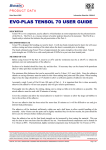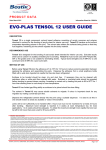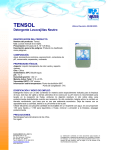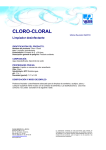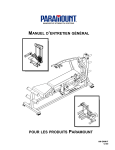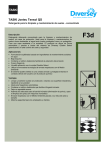Transcript
PRODUCT DATA Date: April 2008 Information Sheet No.: B2065-3 EVO-PLAS TENSOL 12 USER GUIDE DESCRIPTION Tensol 12 is a single component, solvent based adhesive consisting of acrylic monomer and polymer dissolved in solvent for the bonding of acrylic sheet for interior use only. Tensol 12 hardens as the solvent evaporates depositing polymer in the joint. The solvent also softens the surfaces being joined so that they fuse together, hardening as the solvent migrates into the body material . RECOMMENDED USE Tensol 12 is designed for the bonding of cast acrylic sheet intended for interior use only. Extruded acrylic sheet can be used if it is suitably annealed prior to bonding. Tensol 12 must not be used with Perspex ME, SW or AG grades and is not suitable for laminating sheets. Typical bond strengths are 24 MPa for a cold cured joint and 30 MPa for a post cured joint. METHOD OF USE Before using Tensol 12 store the adhesive at 5 to 10oC for 12 hours to reduce solvent evaporation between applying the adhesive and assembling the parts. Dispense the adhesive from a small polythene bottle fitted with a wide bore hypodermic needle that has also been refrigerated. Surfaces to be bonded should be clean, dry and dust free. If necessary they can be cleaned with petroleum ether or white spirit then washed with water. Extruded or machined parts should be annealed before bonding to prevent stress cracking . Annealing is carried out by heating the parts to 80 to 85OC for 1 hour then allowing them to cool slowly to room temperature . Tensol 12 has limited gap filling ability so surfaces to be joined should be close fitting. The solvent in Tensol 12 may cause soluble colorants to migrate. If colour is important check for any migration by making a small test joint first. Dispense the refrigerated cement directly into the joint using a suitable dispenser. It is best to do this in one smooth motion to avoid any bubbles or voids in the bondline. Joints will be set sufficiently to be handled after 3 hours but must not be machined for at least 24 hours after bonding. Maximum bond strength is reached in 3 weeks at room temperature but, for most applications, 1 to 2 weeks should be adequate. To obtain the maximum strength more rapidly the bond can be left for 24 hours then post cured for 8 hours at 80oC. This Product Data Sheet covers just one of a large range of products supplied by Bostik Limited. Full information on these products and advice on application is freely available from our fully trained staff throughout the country. In addition, specialist technical advice is available from our Technical Services Department. This Product Data Sheet supersedes all previous technical information on this product, and users of it are cautioned to ensure that it is the current issue. Destroy all previous Product Data Sheets, and if any doubt, contact Bostik Limited, quoting the code number in the top right hand corner on the front of this document. This leaflet is for general guidance only and may contain inappropriate information under particular conditions of use. The company cannot accept any responsibility for loss or damage that may result from the use of this information, due to the possibility of variations of processing or working conditions and of workmanship outside our control. Users are advised to confirm the suitability of this product by their own tests. Bostik Ulverscroft Road, Leicester, LE4 6BW England. Tel: +44 (0) 1785 272727 Fax: +44 (0) 116 253 1943 www.Bostik.co.uk BOSTIK, EVO-STIK, CEMENTONE & IDENDEN ARE REGISTERED TRADEMARKS OF BOSTIK LIMITED. Page 1 of 1

